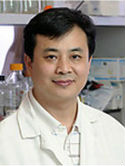Expression profiling of notch signalling pathway and gamma-secretase activity in the brain of Ts1Cje mouse model of Down syndrome Journal Article
| Authors: | Yusof, H. H.; Lee, H. C.; Seth, E. A.; Wu, X.; Hewitt, C. A.; Scott, H. S.; Cheah, P. S.; Li, Y. M.; Chau, D. M.; Ling, K. H. |
| Article Title: | Expression profiling of notch signalling pathway and gamma-secretase activity in the brain of Ts1Cje mouse model of Down syndrome |
| Abstract: | Notch signalling pathway is involved in the proliferation of neural progenitor cells (NPCs), to inhibit neuronal cell commitment and to promote glial cell fate. Notch protein is cleaved by gamma-secretase, a multisubunit transmembrane protein complex that releases the Notch intracellular domain (NICD) and subsequently activates the downstream targets. Down syndrome (DS) individuals exhibit an increased number of glial cells (particularly astrocytes), and reduced number of neurons suggesting the involvement of Notch signalling pathway in the neurogenic-to-gliogenic shift in DS brain. Ts1Cje is a DS mouse model that exhibit similar neuropathology to human DS individuals. To date, the spatiotemporal gene expression of the Notch and gamma-secretase genes have not been characterised in Ts1Cje mouse brain. Understanding the expression pattern of Notch and gamma-secretase genes may provide a better understanding of the underlying mechanism that leads to the shift. Gene expression analysis using RT-qPCR was performed on early embryonic and postnatal development of DS brain. In the developing mouse brain, mRNA expression analysis showed that gamma-secretase members (Psen1, Pen-2, Aph-1b, and Ncstn) were not differentially expressed. Notch2 was found to be downregulated in the developing Ts1Cje brain samples. Postnatal gene expression study showed complex expression patterns and Notch1 and Notch2 genes were found to be significantly downregulated in the hippocampus at postnatal day 30. Results from RT-qPCR analysis from E15.5 neurosphere culture showed an increase of expression of Psen1, and Aph-1b but downregulation of Pen-2 and Ncstn genes. Gamma-secretase activity in Ts1Cje E15.5 neurospheres was significantly increased by fivefold. In summary, the association and the role of Notch and gamma-secretase gene expression throughout development with neurogenic-to-gliogenic shift in Ts1Cje remain undefined and warrant further validation. © 2019, Springer Science+Business Media, LLC, part of Springer Nature. |
| Keywords: | adult; controlled study; unclassified drug; nonhuman; animal cell; mouse; animal tissue; cerebellum; gene expression; gene expression profiling; embryo; animal experiment; animal model; brain cortex; transcription factor hes 1; enzyme activity; brain; messenger rna; immunocytochemistry; quantitative analysis; real time polymerase chain reaction; upregulation; mouse models; neurogenesis; brain protein; notch1 receptor; gamma secretase; notch2 receptor; hippocampus; gliogenesis; down syndrome; gene expression level; gamma-secretase; multiplex polymerase chain reaction; notch signaling; male; female; article; notch signalling pathway; ts1cje; aph 1b protein; ncstn protein; pen 2 protein; psen1 protein |
| Journal Title: | Journal of Molecular Neuroscience |
| Volume: | 67 |
| Issue: | 4 |
| ISSN: | 0895-8696 |
| Publisher: | Humana Press Inc |
| Date Published: | 2019-04-01 |
| Start Page: | 632 |
| End Page: | 642 |
| Language: | English |
| DOI: | 10.1007/s12031-019-01275-2 |
| PUBMED: | 30758748 |
| PROVIDER: | scopus |
| PMCID: | PMC8824580 |
| DOI/URL: | |
| Notes: | Article -- Export Date: 1 May 2019 -- Source: Scopus |
Altmetric
Citation Impact
BMJ Impact Analytics
Related MSK Work





